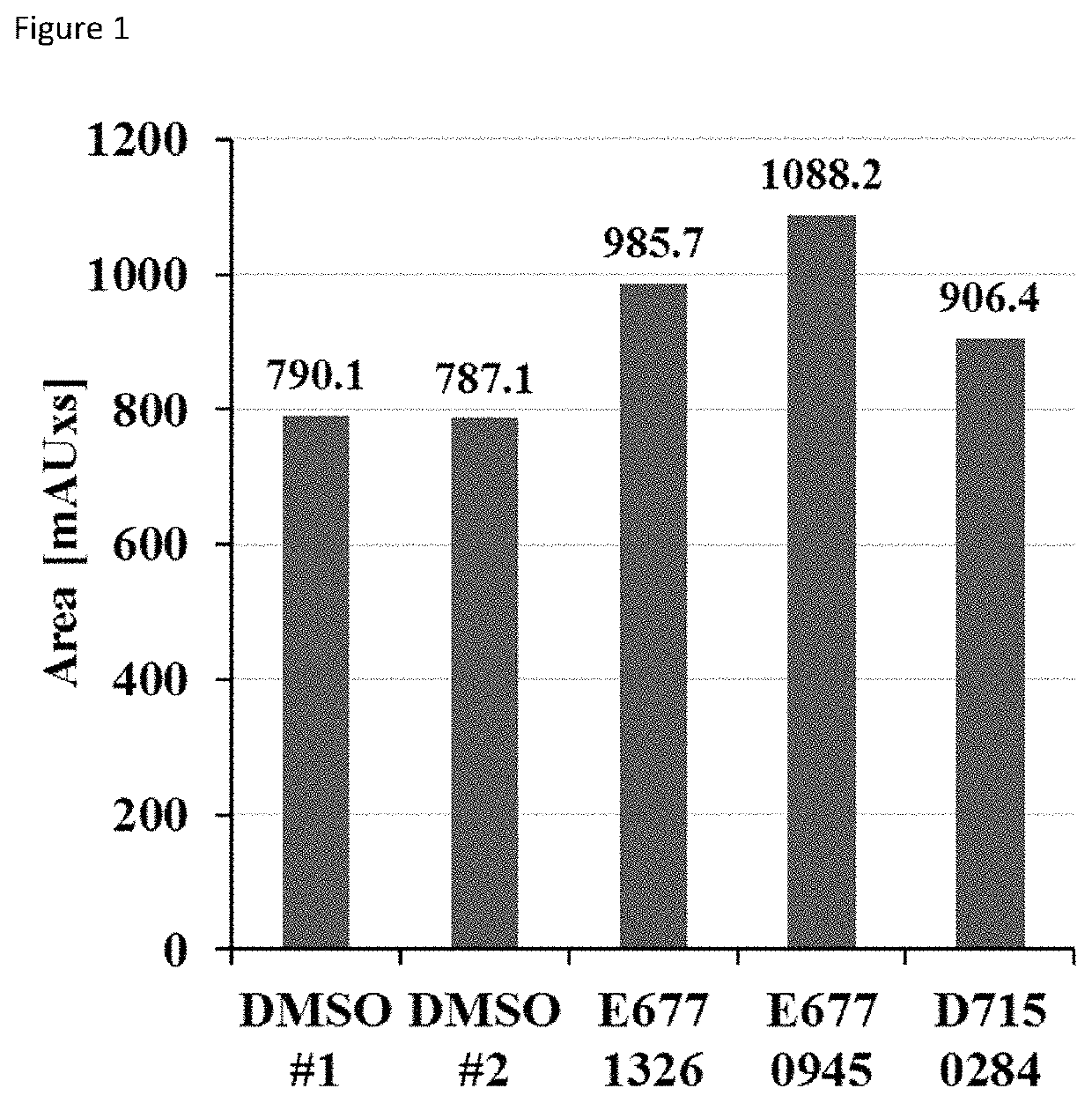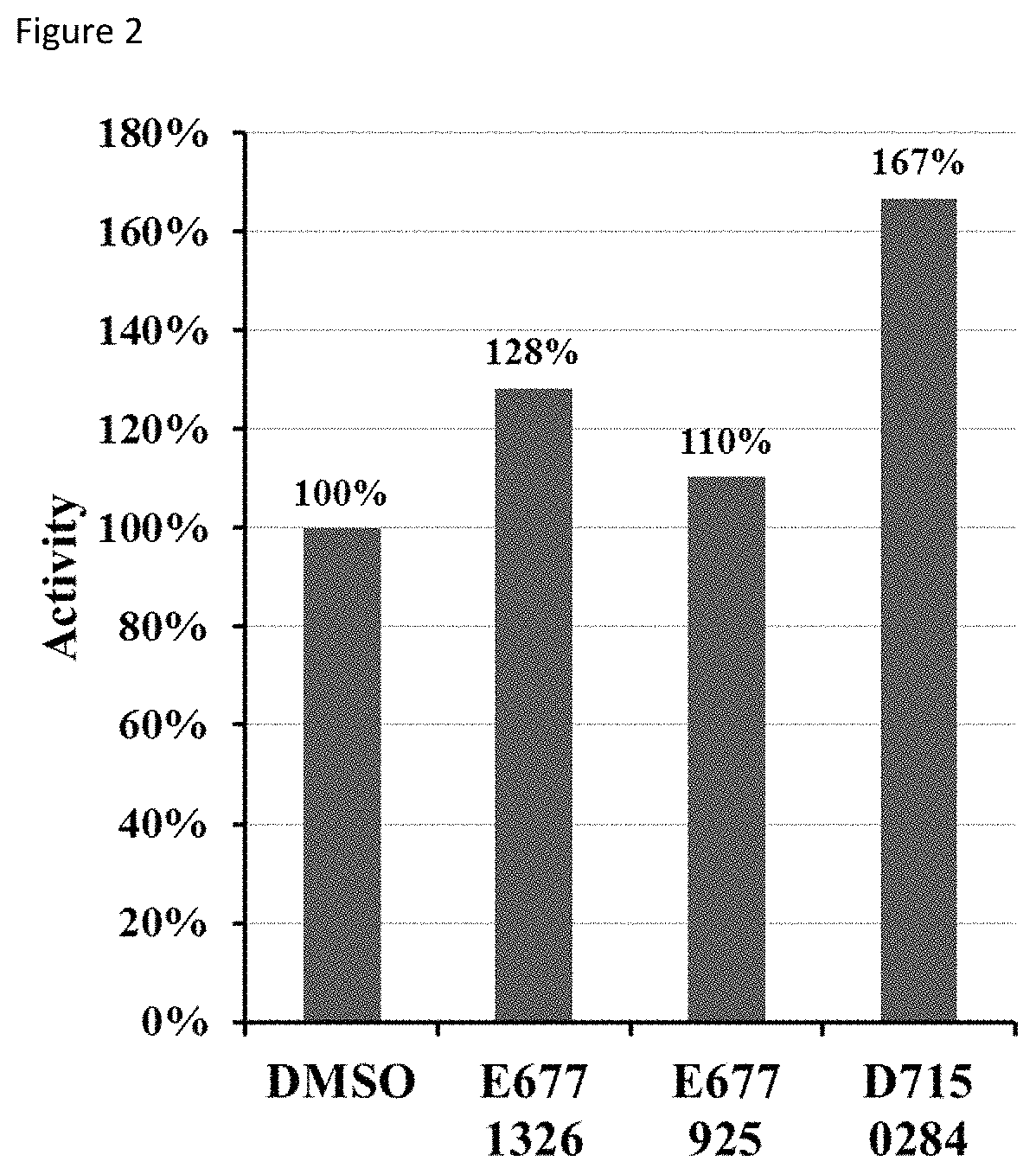Further molecules, compositions and methods for modulation of SIRT6
a technology of compositions and molecules, applied in the field of further molecules, compositions and methods for modulation of sirt6, can solve the problems of genomic instability, hypersensitivity to dna damage, etc., and achieve the effects of promoting genome stability and resistance to dna damage and oxidative stress, high fat, and loss of telomere protection
- Summary
- Abstract
- Description
- Claims
- Application Information
AI Technical Summary
Benefits of technology
Problems solved by technology
Method used
Image
Examples
example 1
on of SIRT6 Activating Molecules and Demonstration of their Activity
[0033]Tables 1-3 below show some exemplary SIRT6 activating molecules, as well as their activity levels in a particular assay, as described below. Without wishing to be limited in any way, it is noted that the molecules in Table 1 showed greater activity in this particular assay.
Expression and Purification of SIRT6 Protein
[0034]Human recombinant SIRT6 (sequence identifier: CAG33481.1; GI:4814651) was expressed in large scale in Escherichia coli strain BL21 as a six-histidine-tagged protein, after transformation of the expression plasmid pET28-SIRT6. The SIRT6 enzyme was purified from the bacteria culture broth in a two-step strategy. The first purification step was carried out by cation exchange chromatography on a HiTrap CM-Sepharose column (GE Healthcare) using an FPLC system. The second purification step was performed by immobilized metal ion affinity chromatography (IMAC) using a cobalt affinity column (Clontech...
example 2
ons and Methods of Administration for SIRT6 Activating Molecules
Pharmaceutical Compositions
[0041]As used herein, the term “excipient” means the substances used to formulate active pharmaceutical ingredients (API) into pharmaceutical formulations; in a preferred embodiment, an excipient does not lower or interfere with the primary therapeutic effect of the API. Preferably, an excipient is therapeutically inert. The term “excipient” encompasses carriers, diluents, vehicles, solubilizers, stabilizers, bulking agents, acidic or basic pH-adjusting agents and preservatives. Excipients can also be those substances present in a formulation as an indirect or unintended result of the manufacturing process.
[0042]The term “sublingual administration” refers to the mode of administration of a medicament to the tissue under the tongue.
[0043]“Treating” or “treatment” of a disease includes: (1) preventing the disease, i.e., causing the clinical symptoms of the disease not to develop in a mammal that...
example 3
l Validation of Three Molecules
[0071]The activating effect of three compounds (ChemDiv ID E677-1326, E677-0945 and D715-0284) for SIRT6 was validated by conducting the following secondary assays. As previously described, D715-0284 is a stereoisomer of molecule 768382-41-8.
[0072]1. HPLC deacylation assay. SIRT6 was incubated with compounds and myristoyl-lysine peptide (corresponding to TNF-alpha sequence) at 37° C. The deacylation reactions were analyzed by reversed phase high-performance liquid chromatography on Kinetex C18 column by monitoring the formation of the deacylated product at 214 nm. The results are shown in FIG. 1, which shows the area under the peak corresponding to the deacylated product. Equally diluted DMSO served as control.
[0073]2. Fluorometric deacetylation assay. SIRT6 was incubated with compounds and fluorophore-labelled acetyl-lysine peptide (corresponding to histone H3 sequence) at 37° C. FIG. 2 shows the effect of compounds on SIRT6 deacetylation activity. Re...
PUM
| Property | Measurement | Unit |
|---|---|---|
| temperature | aaaaa | aaaaa |
| mean diameter | aaaaa | aaaaa |
| weight | aaaaa | aaaaa |
Abstract
Description
Claims
Application Information
 Login to View More
Login to View More - R&D
- Intellectual Property
- Life Sciences
- Materials
- Tech Scout
- Unparalleled Data Quality
- Higher Quality Content
- 60% Fewer Hallucinations
Browse by: Latest US Patents, China's latest patents, Technical Efficacy Thesaurus, Application Domain, Technology Topic, Popular Technical Reports.
© 2025 PatSnap. All rights reserved.Legal|Privacy policy|Modern Slavery Act Transparency Statement|Sitemap|About US| Contact US: help@patsnap.com



